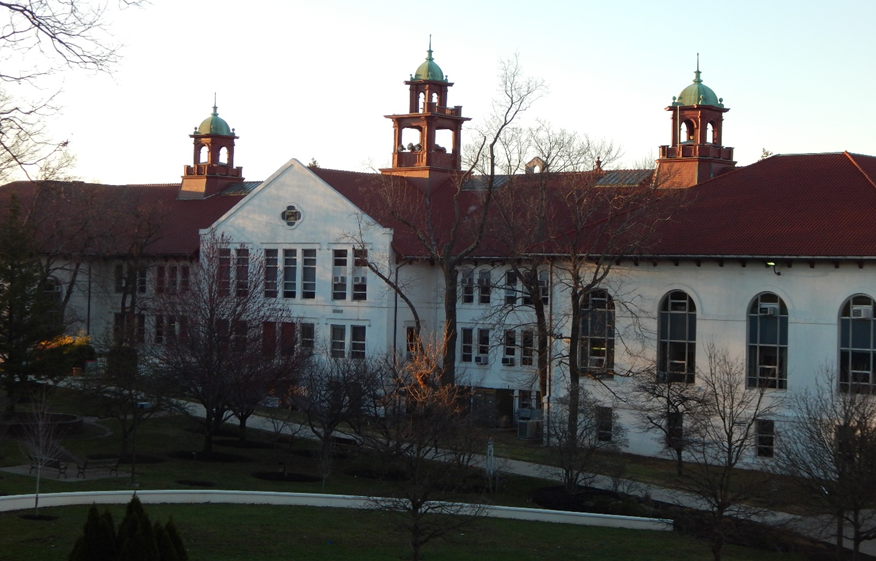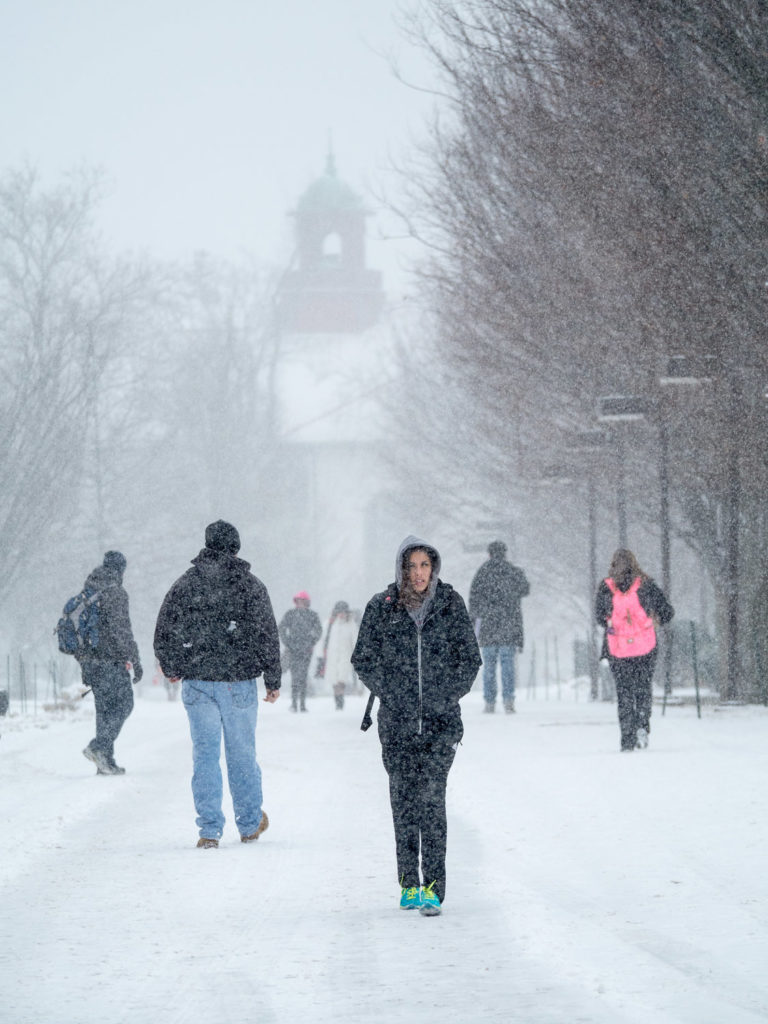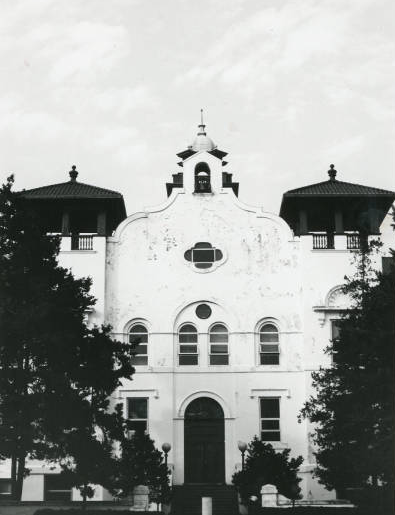Every morning at 8 a.m., a slow, methodical bell tolls from the peak of College Hall, a burgundy tower with a minty cap that stands out against the otherwise stark white building. The sound is rich and purposeful, hearty and lingering, but, despite the mighty toll, hardly a passerby seems to take notice.
A professor wearing a grey tweed jacket and matching cap hurries out of the building and along the concrete pathways without looking back. A student, too busy bopping to the beat of the music flowing through her earbuds, cuts almost robotically across the Alumni Green, directly in front of College Hall and its weathered bell tower without the slightest notice of its sound.
The carillon (pronounced kah-ri-lon) an instrument composed of bells and an automatic mechanism that plays them — is part of the rich history of Montclair State University. The bell tower has become one of the most quintessential symbols associated with the university, permeating more aspects of everyday life on campus than many would assume. It’s become so much a part of Montclair State’s history that whispers from the past seem to flow through the iconic sound, which still rings across campus in the modern day, although it seems to go largely unnoticed.
Paul Martinez, cataloging librarian and archivist for Sprague Library, argued that “the carillon provides an important connection to our past. Twenty years from now, when you’re coming back to Montclair State, it’s likely that the campus will have changed a lot, but College Hall will still be there. I hope you’ll hear the carillon play the alma mater at noon. I hope it’ll remind you of your graduation when your family and friends were cheering you on, and you were about to move on to a new phase of your life. Where else will you hear that song?”
The bell’s history dates back to before the university opened its doors. In 1907, Edward Russ returned from a California trip to oversee the construction of the first buildings on what is now Montclair State’s campus. In love with Spanish mission-style architecture, Russ designed the building complete with an ivory bell tower to house a mission bell. In the following years, the bell consistently rang out for the miniscule student body and faculty to enjoy.
In the 1950s, the bell was controlled by a paper tape moving in time with a master clock and acted as a time keeper as well as a fire alarm and a warning system. The sound was crisper and shorter than it is today, though arguably more authentic than the electronic version currently used (the Sprague Library archives has a recording from 1961).
In 1965, the bell fell to silence. No sound rang from the tower until 1975, when Dorothy Wescoat, class of 1933, donated the university’s first carillon. With the bells ringing out all the way to the Student Center, the sweet sound was once again a staple on Montclair State College’s campus — the institution didn’t gain its university status until the 1990s. Back then, musical selections played twice daily.
In the years that followed, the carillon and the iconic bell tower were regarded as “a symbol of campus unity [that] rings out freedom,” according to an article in The Montclarion in October 1988.
Cindy Meneghin, director of Student Communications, who now oversees the operation of the carillon, said that she finds the sounds from the bells to be iconic and inspirational. “The bell tower is our traditional symbol that I know we all take great pride in,” she said. “It really is a call to carpe diem — a reminder that we are all called to work hard and achieve our goals and dreams, and I hope the students feel the same sense of pride and tradition.”
Martinez understands that the bell tower tends to be overlooked by students and faculty. “From a busy day-to-day perspective, the carillon bells are a small thing,” said Martinez, “but small things can become important later in life. They provide important emotional connections to the past.”

The College Hall bell tower is a quintessential part of Montclair State University since this founding.
Photo Credit: Victoria Testa
Today, the bells still ring across campus, although they are not noticed nearly as much as they have been in past years.
The actual control box is housed in a storage closet on the third floor of College Hall, connected to speakers in the bell tower which project the sound across campus. The carillon plays the alma mater every day at noon and Westminster chimes every 30 minutes. During sports games, the speakers sound the fight song, and on special occasions such as 9/11, other tunes are played.
The vision of the bell tower remains an important symbol and reminder of Montclair State’s remarkable past. Our yearbook La Campana — Spanish for “the bell”— was named after the College Hall bell tower in the 1930s. The red silhouette of a bell remains on our coat of arms. In University Hall, many of the podiums are outfitted with an image of the bell tower — a picture that has consistently appeared hand-in-hand with the school’s name since its inception.
When the carillon was last repaired in fall of 2014, students and faculty seemed to be grateful for its return. Besides the fact that the bell provides a resource that can quickly alert students, faculty and staff in the event of a campus-wide emergency, many students argued that the sound made them feel like part of a family — and, of course, helped them not to be late.

Through all weather, the tower remains a staple in the campus architecture.
Photo courtesy of Mike Peters
Plans for the bell tower at Montclair State do not end with its most recent repair. Meneghin said that once the upcoming construction projects at the School of Communication and Media, Partridge Hall and College Hall are finished, the university plans to extend the sounds from the bell tower to all parts of campus using strategically-placed speakers. They will do sound tests in both winter and summer to ensure that all areas of campus will be able to hear the chimes, music and announcements from the bell tower no matter what season.
These days, some students are completely unaware that we even have a carillon. “I’ve honestly never heard it,” said Rachele Petronella, a junior family and child studies major.
Others continue to appreciate its home on campus. “I’ve heard it when I walk on campus, especially around noon,” said Sarah Vazquez, a junior English major.
“The fact that people don’t know about [the bell] is surprising,” Vazquez said as the shock registered on her face. “I think it’s always important to reflect on our history and keep the good aspects of it.”
For Karen Pennington, vice president of Student Development and Campus Life, the sound of the carillon is important. “I’m not surprised that some students don’t acknowledge having heard the bells,” said Pennington. “As people, we often get so caught up in what we are doing that we miss the things around us. I very much enjoy hearing the bells chime every day, [because] they give the campus a very traditional feel and sound.”
Sprague Library offers a rich collection of information about the carillon and campus history, and the staff is always happy to speak with students and faculty about Montclair State’s past.
If you’d like to experience the carillon’s sound for yourself, the amphitheater provides an excellent natural echo for the booming chimes, as well as a beautiful view of College Hall and the bell tower — both of which provide an everlasting whisper of the past on our modernized, constantly evolving campus.



